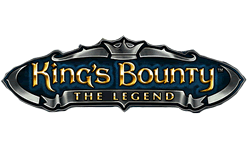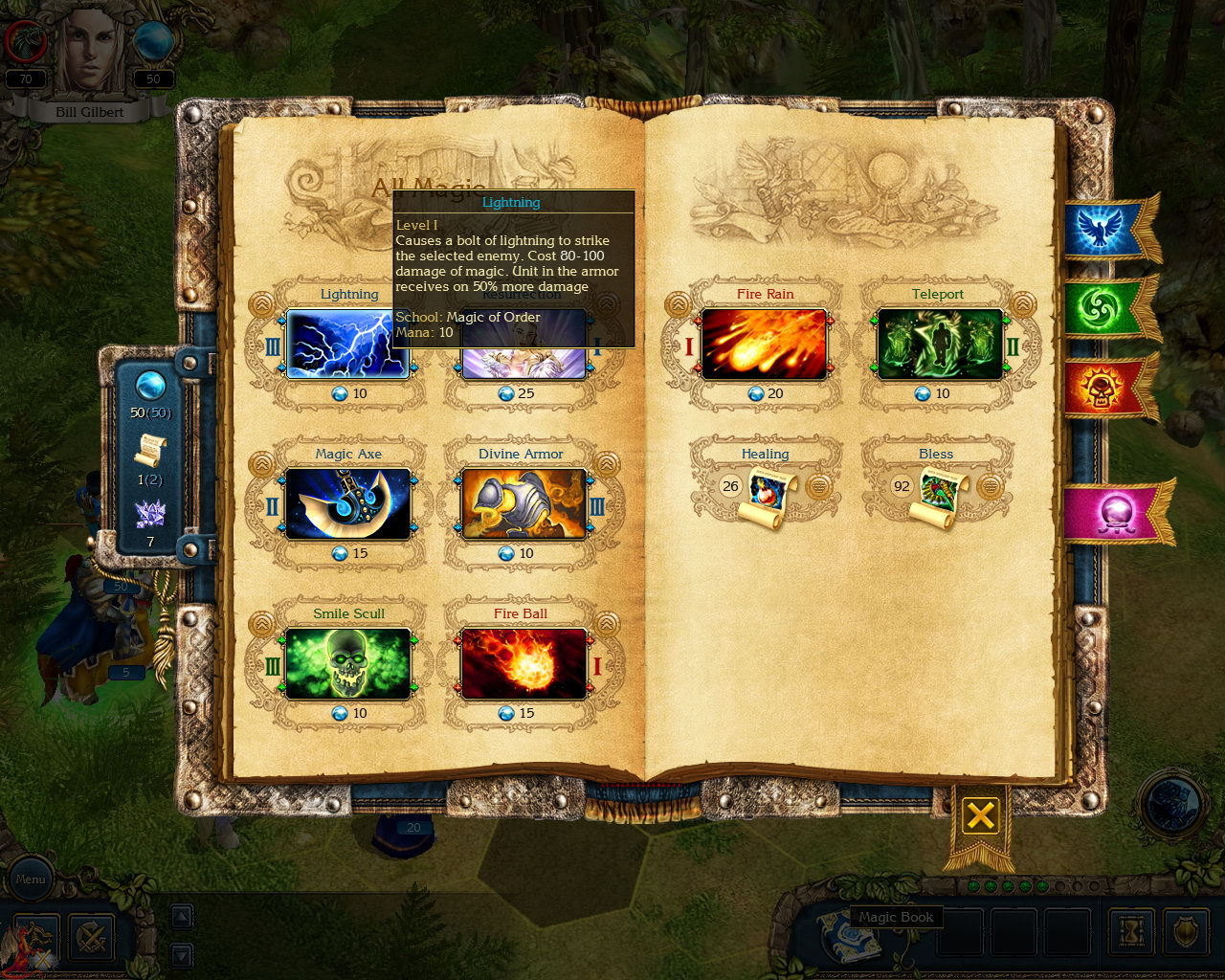|
|

|
PLATFORM
|
PC
|
BATTLE SYSTEM
|

|
INTERACTION
|

|
ORIGINALITY
|

|
STORY
|

|
MUSIC & SOUND
|

|
VISUALS
|

|
CHALLENGE
|
Adjustable
|
COMPLETION TIME
|
20-40 Hours
|
|
OVERALL

|
+ Malleable Battle System
+ Writing is funny
+ No two games the same
- Story a tad shallow
- Easy is far too easy
- Optional quests too similar
|
Click here for scoring definitions
|
|
|
Back in 1990, a game was quietly launched for early computer models called King's Bounty, which meshed early RPG elements with strategy flavouring. Most RPGamers would likely know the successor to the game, as it went on to spawn an entire series called Heroes of Might and Magic, which eschewed many of the RPG elements to add in additional strategical facets. Eighteen years later, a successor to the original game comes in the form of King's Bounty: The Legend. The sequel returns to the same blend of RPG and strategy called for by the original, with up-to-ddate graphics and mechanics. Though hampered a little by a rather shallow story and questionable difficulty levels, the good points far outweigh the downsides, as the game is an entertaining romp of armies clashing in battle, some very quirky writing, and plenty of replay value.
There are three classes to choose from at the start of the game, and each will resolve problems in and out of combat through different means. The Warrior is an effective fighter and uses the Might talent tree, relying heavily on his army (although he can reduce casualties in a variety of ways). He will also focus more on Spirits of Rage, eschewing magic. Conversely, the Mage is very reliant upon his mana pool, spell book, and the Magic talent tree. The type of troops he brings into battle is not as pivotal to his combat strategy, as he can simply buff any troops or raise them back from the dead with necromancy. The Paladin is the third class, primarily focusing on the Mind talent tree, and revolves around the Leadership mechanic -- which determines the maximum number of troops a hero may recruit. Paladins are charismatic, able to recruit units from the enemy; at the height of their power, they can upgrade the Priest unit into the ever-powerful, extremely rare Inquisitor class, which can resurrect its fellow troops, meaning Paladins can be the most powerful class available once they get rolling. Players can and should specialize outside their tree: a Mage dipping into the Mind tree for increased Leadership is never a bad idea. Any time a player levels, they will acquire additional runes which may be used to purchase talents in the trees; they may also be found in the world, as treasure during combat or as a reward for a challenging or long quest. Generally, each class receives more runes for its specific tree than for those native to the other classes, although diversification is not impossible.
 A Small Army
A Small Army
|
|
From the meanest peasant to the noblest of the dragon races, a variety of allies can be called upon to battle under the hero's banner. Up to five stacks of allies can be brought to battle, though the number of each type is defined by how much leadership the main character possesses. Most units will have a finite stock in each location on top of costing gold to recruit, so a player cannot throw away troops cavalierly. Depending on the number of quests a player performs, one factor or the other (the gold or the limited number of recruits) will undoubtedly be more pressing. Once the hero's army is prepared, it's time to sally forth to complete a variety of quests. The main storyline will have the player running to and fro across all of the major continents of the world, and in many cases quests will have multiple solutions. Sometimes, a quest objective can be persuaded to talk instead of fight; the choice is refreshing, but be warned, there are permanent consequences to any action. Taking out a castle's leader usually means the player can no longer recruit into their army from that location and one choice may even seal off a portion of the entire world.
Combat is simple to learn, challenging to master. The hero himself does not fight, but instead merely oversees his troops, casts spells, and releases the Spirits of Rage. Every turn of combat, each individual troop stack will get the change to perform actions; what they can do depends upon what sort of creature they are. Peasants creep slowly forward, only able to move two spaces per turn. Dragons on the other hand, being large winged creatures, can traverse nearly the entire battlefield in one movement. Many of the hero's troops have special abilities, such as a flaming arrow for archers (doing extra damage to anyone weak to fire) and a speed boost for bears (allowing them to move an extra two spaces one time during combat). Some abilities are a one time per combat use, while others after a cool down period can be used again. Combat is complete when one side is decimated or has retreated. Never forget that equipment plays an important role in combat; a player may acquire the usual assortment of weapons, armour, and relics which provide a variety of bonuses such as reduced leadership for a certain type of mob or extra stat points.
Upon completing several storyline quests, the hero will acquire a unique item called the Chest of Rage. Though nothing more then a curious artifact at first, the box contains four Spirits of Rage which can be unlocked by performing tasks. What each Spirit would like the hero to do varies: one challenges the protagonist to defeat him in battle; another wants the hero to gather poisonous snakes and spiders that the spirit will consume; a third requires recharging; the final Spirit seeks a lost artifact. Each one levels up individually and will unlock a total of four abilities. Further levels strengthen or reduce the cost of these abilities. Every ability has a cooldown, where the Spirit needs to rest before he or she can be called upon again. Normally, one ability from the Chest of Rage can be used per turn.
The game is set in a colourful 3D environment reminiscent of the artistic styling from the previous KB/HoMM titles. Players will encounter the usual host of allies and enemies, from animals to the more noble knights and archers, down to crawling snakes, spiders, and man-eating plants. The undead also arrive in the form of ghosts, vampires, skeletons; hellish minions including succubus, imps, and demons can also be tapped as the hero finds locations to recruit them. Each unit has a nice amount of detail and the background maps have a decent amount of variety moving from zone to zone. The music is good in that it sets the mood and tone for the various maps without being obtrusive; while it wouldn't be something a player would hum outside the game, it's well done. The sound effects conversely are more of a mixed bag. While the sounds accompanying the varying units, particularly wild animals, are not offensive in and of themselves they are often repeated far too frequently, making certain units undesirable for their sheer annoyance over their combat prowess.
King's Bounty has three difficulty settings, though they don't scale particularly well. Easy mode is incredibly easy, with the AI making rudimentary poor decisions. Both the normal and hard difficulty settings are far more balanced and the computer-controlled enemies don't seem quite as ridiculous. A regular game, taking into consideration performing about half of the side quests, will take a player about 25 hours to complete. Those playing on easy or skipping much of the side diversions will find their adventure completed in slightly under 20 hours, while the completionist will find their adventure spanning upwards of 35 to 40 hours, as additional time is invested into exploration and preparation -- this is particularly true for players who have pitted themselves against King's Bounty's hard Mode.
The interface throughout the game is clean and simple to navigate. Swapping equipment, accessing and learning spells, or having intimate conversations with the wife are all easily accessed with little fuss and no digging. Information is duplicated to a small extent, but only in relevant places -- for example, seeing how many crystals are available both inside and outside the spell book lets the player decide whether a large patch behind a strong enemy guard should be pursued now or later. The text in the game is also handled well, with only one or two minor spacing snafus and no particularly glaring misspellings. It's clear that a lot of care was put into the title, even outside of Russia.
 Spellbook
Spellbook
|
|
The story of the game is simple: take on the role of the King's Royal Seeker, and do as he commands. The world is in chaos -- Dwarf against Human against Elf against Demons and other supernatural forces, it seems at first nobody can ever get along, though in the end the story ends up being a bit shallow. Doing many of the side quest arcs, varying in length from a single quest to arcs as long as the main story path, helps fill in the dynamics of a grand world that bears exploration. One clear motivation for doing the various optional quests is the ability to marry. The hero may woo the girl of his dreams or nightmares by performing tasks and then asking for the "lucky" lady's hand. Each wife gives a different bonus, and most of the women actually have two forms. For example, one lovely maiden the hero may marry was originally a frog but turns into a human when lovingly smooched. Originally starting with four equipment slots, as the wife bears children they will fill these slots, with each infant providing a bonus to the hero as well. Having a large family was never so easy, or so rewarding. Monogamy is in style -- the hero may only have one wife, though he may cast her off. She will take half his current gold, any equipment she is wearing and all the children she has borne.
There's a lot of originality to be had, as the game feels very like a refreshing break from the standard RPG formula. The great thing about King's Bounty: The Legend is what flaws it does have are minor, and don't detract from the overall game experience, which is fantastic. That being said, those that value an epic story over other facets such as an addictive combat system should steer clear. Possibly the best part of the game is the fact that despite being for a home console it can be treated very much like a portable game, with the ability to pick it up and put it down if a player only has limited time to dabble. Then again, once started it's hard to stop playing. Just five more minutes and this quest will be done! Then again, there's always another task to complete...
Review Archives
|









